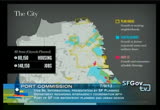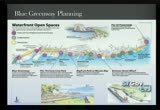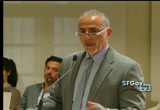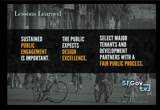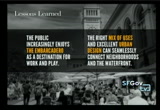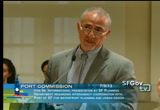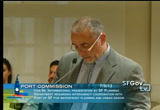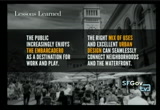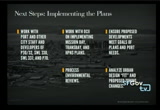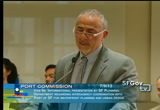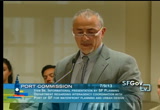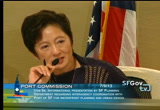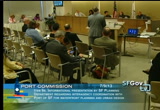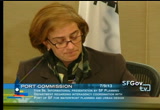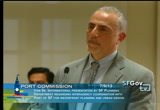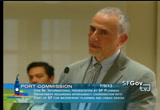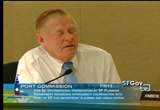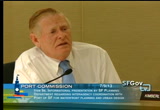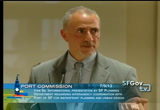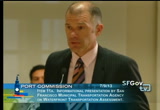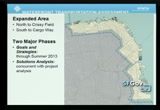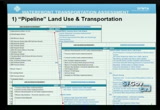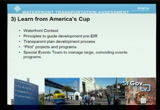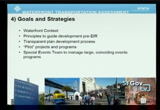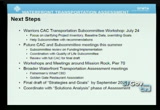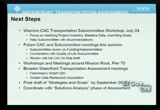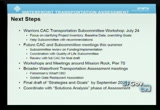tv [untitled] July 31, 2013 11:00pm-11:31pm PDT
11:00 pm
the most part the areas where most of the growth will happen are adjacent to the eastern waterfront. in all cases the plans focused attention on connection to the water and the consistency with the plan. the port was at the table with all of the planning efforts and we felt it was very important that our planning work was consistent with the policies and direction of the waterfront plan. it's not just about connecting to the waterfront but it's about extending the neighborhoods to the waterfront and that was an important element of the plans. it was about creating a seamless neighborhood if you will or a series of neighborhoods to the up lands to the edge of the water. i also think -- what we're trying to show here how all the plans overlap and come together and those plans of
11:01 pm
the waterfront that we are planning today so namely pier 30/32 and the sea wall and and all of those have been adopted by recent years and covered by the water use plan and all of those are about the work we're doing today is about implementing the plans that have been worked on for the better part of 20 years. i also wanted to mention -- oops i am going the wrong way. i also wanted to mention the work the port has done with the planning department and other agencies on design and access issues on the waterfront. as you know -- as diane mentioned it has the water element and i know there are other presentations happening on that as well. my view -- excuse me, my view is that the blue green way is one of the most important elements of that because it
11:02 pm
creates a continuous multi-mile access system through the entire waterfront through mission bay to hunter's point and extends the trail through the city and it's a way of combining us to and connecting us to the larger region. other realms include jefferson staff and the first phase was unveiled. we are very proud of that and it's a model to do the work in other parts of the city and just to let you know we have an entire team devoted to this type of work. it's the city design team within the planning department. they're focus focused on improvements to the public realm and this grew out of that and our streets represent 25% of the land area of the city and more than the parks combined, so the basic
11:03 pm
coal of that program is. >> below look at it differently and recognize they represent great public spaces in the city and can be much better than they are today so i wanted to go over what we have worked with your staff about the lessons learned in this process and what we are doing today to kind of further carry out this work. most of these -- these are summary statements of what is in your memo and i won't go over them in detail but one of the things that is absolutely essential and i think has learned lessons over the year on this point that public engagement isn't something you do once in a while and walk away. it's something you do continually throughout the process and the work you have done exemplifies this and the public expects design excellence especially on the waterfront, and that we --
11:04 pm
the major tenants and development partners expect and we should expect from them a fair public process. we've learned of course that consultation with the appropriate agencies bcdc and state lands in particular is key and that consultation needs to happen early. we know that projects need to promote -- and this is clearly called out in the waterfront use plan and promote access and water use where possible and pier 70 is the best example of that where we can do both. obviously the public has -- as monique pointed out earlier and there is attention to the embarcadero in the recent years and the thing that we learned in terms of actual land use uses and the right mixes and urban design do what i said and connect the neighborhoods to the water in a seamless way. all
11:05 pm
of these were called out in principle in the plan and the neighborhood plan and the work we're doing today is about implementing those so i wanted to mention a few things and talk about where we're going today in the next few months. i just want to point out urban waterfronts around the country and world are really being reimagined. many great cities are doing what we're doing today and there is amazing creative work going out out there now. this also plays a major role in the city has a multi-faceted economic base and there is an interesting question. we struggled with the eastern neighborhood planning work and much of the work is focused on the city that was zoned for industrial uses and we were really tossed around a lot to be frank from both sides of that argument from those that believed there is no more need
11:06 pm
for industrial land in the city and rezone it all and those that thought we shouldn't rezone any of it and maintain that base in the city. we rezoned half it. i guess we made everyone unhappy but what i learned in the work if everyone is unhappy with the work we must have done the right thing, but the point is we're facing an interesting situation and there is increased demand for industrial business in the city and we are working with sf made to find new industrial land and space in the city and no one would have imagined 10 years ago but there is in fact a growing demand for it. we have the lowest percentage of industrial land of the major city in america and less than 7% of the land and it's important for lower property values for those uses to be maintained. i believe the port plays a large role in that and maintaining
11:07 pm
the uses are important component for maintaining diverse economic base for the city and for the businesses that have no where to go otherwise they would go outside the city to do what they need to do. it is true of course that waterfront access is a key component and i think one of the wonderful things about the san francisco waterfront it combines both of those things and maritime and public access scprt activities. it's not about wiping the slate clean and starting over so the plan has expanded the shoreline system. it has integrated areas for development and accept regional growth in a smart way. now we are looking at ways of implementing this work and what is causing some of the consternation out there is is that there are large sites
11:08 pm
out there and i understand that but it's important for staff to understand that the developments implement the planning work that we done and ensure that the connections between the waterfront and the neighborhoods are happening and all of the cases i believe these sites carry out the goals of the plan for robust access to the water and mix uses protecting maritime industry and neighborhoods to the water and preserving the historical legacy of what is already on the waterfront. i think it's important since the rehab of pier one and the ferry building and the listing of the embarcadero district on the national register of historical places the port has made great strides in this area. the waterfront design and design and development and the plan provide a framework for additional rehab efforts we're are working on as of the port thinks about the
11:09 pm
future and the context of sea level rise and the finances that could pay for the rehabilitation of the piers and you know recognizing the historic properties and making sure they have a viable economic use and i will close with what we're working on and some of the next steps as we move forward with your staff and other city agencies. we are working with the developers of these important sites and your staff and other city agencies on implementing the policies and plans and recommendations of the waterfront plan and the other neighborhood plans that i mentioned. to meet the goals of these plans we are being asked to consider changes to zoning which include looking at height limits, looking at density requirements, and we are looking at those very carefully. it's understandable that these requests are coming forward because the cost of developing these sites are more clear than they have ever been since the developers understand what
11:10 pm
the real costs are. as i pointed out earlier the sites are large. they accommodate a huge amount of growth and play important part in this and we are analyzing the proposals and working with staff and the developers and i dare say our work far exceeds work that we normally on projects of this size and the protocol of the sheer number of projects the department reviews and start working with the project when the application comes in the door. these large projects haven't formally applied for approvals yet. we have been working with staff for two years and recognizing how important they are and making sure the goals of the planning efforts is carried out through the plans so we have gotten involved early on in the planning and development of these sites, far earlier
11:11 pm
than we would normally would in the development process. in all cases i think it's important it is been very clear that a goal of these plans and these developments is to maintain and enhance and to carry out the goals of the waterfront plan, the adjacent neighborhood plans and the larger economic and demographic goals of the city, so i want to close by thanking all for the time and particularly thanking you for the excellent collaboration that we have with the port. i think that the relationship that we have with the port staff on all levels is extraordinary. it's almost like working with one's staff. there is a tremendous amount of respect from the director level down to the staff levels and it is really i think an almost a combined work plan if you will that we have been trying to implement for many years and i really appreciate that and i really appreciate the support of the director and all of you in making that happen.
11:12 pm
that concludes my presentation and i am happy to answer any questions. thank you. >> thank you very much. is there any public comment? commissioners comments? well, i would like to thank planning director figure coming today. i think. >> >> this is something that is comprehensive, many of the things that come in from the port is transactions and leads the impression we're dealing with individual projects and not connected and no vision and no strategy and i think you assured us and aware that these plans are worked in close coordination and i think we just -- the fact that you came here today and took the time and really appreciate it that there is something that is integrated and coordinated and you're connecting the dots and we at the commission get the big picture as well as how the transaction fits into the map and the portfolio for the
11:13 pm
port and that is important and while we fight daily battles and there are many of them now and it adds up and work and vision and there is also great working relationships with all of the agencies which we appreciate and i think you get that sense. we had a positive meeting so far in terms of the executive director's report and the commendations we have given and i think that is very important and i want to say thank you and i know you're a busy man and we appreciate you came today and to do this for us and put this in perspective and we have two other presentations that will add to the fabric of what we're looking at today. >> thank you. >> ditto and i want to thank you for coming and for highlighting the collaborative nature of the two departments. i think that really does serve the city well and demonstrates how we can end up better off so thank you for coming and for working on all
11:14 pm
these various projects. a couple of things. i appreciate your pointing out and mindful of the impact that some of the plans do have, and as you point out in not losing all of the industrial zoning taking a moment in time and think about the impact of what we're doing for future generations. i know it's something that we're all very mindful of. one thing too you mentioned the high line and you probably haven't heard by repeated rants but it's one of -- my favorite projects we're working on because i think it's going to have an impact on making and keeping the waterfront accessible and really drawing people again down to it. i'm sorry. the blue green way and look like the high line in a sense it becomes a
11:15 pm
destination in itself and if the staff and yourself have any thoughts how we can achieve that in a fiscally prudent way i would certainly welcome that but it's an important for us to really connect this waterfront to have something uniform in terms of signage and parklets and the open space and creates a great opportunity for us and i want to highlight that once again, but again your presentation has pointed out too with all the growth happening on this side of the city this is really where the face of san francisco will be changing for generations to come and we need to be mindful of that impact on our city and be thoughtful about how we do it so i appreciate all of your work with us on that. >> thank you very much. >> thank you. >> i would like to say -- john, i would like to say i really
11:16 pm
appreciated your presentation and i liked the fact that you said the planning commission and two staffs and you said "a lot of these things i didn't start -- but it was unique "i know how to get it done" and i'm going to call you to be a closer and something you said and there is a shift of jobs and from one area to another but one thing i liked they stayed here in the city and most cities jobs are being sent overseas and you said the shift went from one area to another and i appreciate the fact that you monitor that i was much wag how that was happening so thank you. >> thank you. i might point out if i might you probably have seen -- i grew up in the city of detroit which of course is like the polar opposite of what is happening in san francisco
11:17 pm
these days. the median price of a house in $9,000 and the city is going through this extraordinary upheaval and those jobs have been lost through the city to other regions and other parts of the country and people weren't paying attention and i really do believe -- and i know this is my bias and detroit made 80 years of bad planning decisions and part of the reason it's in the situation it is today and i really think the years of good planning in san francisco have really made a difference. i'm sorry commissioner. >> i want to thank you for your presentation. i think you're definitely a big picture guy, but you did say there that you have somebody working on that application the minute it comes in the door, the big stuff, and i know we're talking about the port today and the big stuff, but it's still the small
11:18 pm
stuff which also supplies housing and jobs in san francisco. it's still taking far too long. i know you have tried very hard to improve the communication and the connection between planning and dbi. you brought in a new guy recently, and i believe that's working out pretty good, but you may have to hire more staff, but i think it's important that the small guy, the homeowner, and the guy doing the horizontal addition that he is treated the same way as the big developer that comes to san francisco. that would be my wish to see that one day, and you know again i think you probably have to hire more staff to get that done. >> yeah. i appreciate that concern commissioner. in fact we are hiring staff because the current economic conditions in the city -- we're seeing a huge number of new applications
11:19 pm
come in the door so by the end of the year the department will be as largest as ever and we would have hired 30 new people by the end of the year and we can do that because of the development activity going on and paid for by development fees and not from the consequent fund and my current director jeff eric -- johnson is doing that and we are focused on the large projects and we are giving the smaller projects that don't take as much time and get them out the door quickeer. >> yeah, they're the small and medium projects, the ones that pay the staff. we're self
11:20 pm
supporting there and i would like to cranked up a little bit. >> understood. >> thank you for a wonderful presentation and thank you for paying attention. >> thank you for having me. >> john one other thing and director moyer it would be good to have john every six months and i have never seen you before except on tv. >> you watch? >> i know it's brutal but i would like to see you come because it helps me understand being a new commissioner and the rest of the commissioners that i am learning from so i appreciate you coming more often and sit down to us and we can know and i'm more of a hands on person and i would appreciate it. >> i would be happy to and i will point out i'm giving the same presentation to the planning commission and august 1 and happy to hear from them as well. >> that's great. it looks like it will serve many purposes
11:21 pm
and we're sensitive to the fact that the general public doesn't know how much coordination and work is going on between the various agencies and there is a vision and there is a bigger plan and it just isn't about transactions. >> thank you very much. >> thank you. >> commissioner, due to scheduling conflicts challenges with your permission we would like to take two items out of order and we will be heard next. first will be item 11a and then 12a and back to 9c if that is okay. >> yes proceed. >> item 11a informational presentation for san francisco municiple transportation agency on waterfront transportation assessment. >> thank you. good afternoon madam president, members of the commission. peter albert from mta. i came to you a couple of times in the last six months what doing on this transportation assessment and what we would like to do is
11:22 pm
highlight a major milestone we're reaching. i would like to call this the beginning of the conversation we want to have this summer. it's very much related to what director ramos of the planning department. as you know the waterfront assessment is looking at the transportation along the waterfront and before i talked to you about the boundary of what we're trying to do and i got a change i want to highlight which is this change here. we're not just talking about a limited part of the waterfront. we're looking at the waterfront down to the hunter's point shipyard. it's because of the community feedback we've had and what it means to do waterfront planning -- oops get back -- on waterfront planning that we decided to include fisherman's wharf, we include what is happening beyond the boundaries of the focus area and to the north and that's how transportation works. transportation is a network that goes beyond the development
11:23 pm
area. the other highlight is how much simpler we're trying to describe what we're doing and it's been confusing to people and look at the waterfront assessment in two ways. we're launching the goals and strategies part of it and i will get into that a little more and at the end of the summer that should be a final document so right now if you go on to the oed or port website you will find the draft of the waterfront assessment outlining the goals and strategies approach. at the end of the summer we will get into solution analysis but before that i would like to you walk you through qhat goals and strategies covers. the right place to start sending what the baseline is and we have talked about what call the pipeline. it's what the planning department is given us information about the major developments you heard about. it's the transportation projects we have been working on as well and we have gone to workshops and outreach meetings to establish these projects
11:24 pm
coming online are going to change transportation. we know what they're going online but we want everyone to understand the snapshot of today and 20 years from now is already changing because these transportation investments and programs are happening. on the slide there is a thumbnail of some of the major ones, the central subway, the cal train extension downtown and the high speed rail and pedestrian and bicycle projects as well so to be clear that the pipeline is a good place to develop what are the right strategies and goals and in that of course was this massive inventory that we have under taken understanding -- these are graphics from the workshops. on the left is the projects that we knew about from the planning department. on the right in blue were the major transportation projects or the not so major ones but understanding how important it is not just to recognize them but line them up so they're
11:25 pm
choir graphed and coming in when needed. >> >> you have these investments and developments happening in concert and the second stage is the outreach. we had a number of workshops particularly about the warriors project and the giants project and pier projects. they had work groups and we had meetings last week, but taking all of the input from the community outreach and looking at the pipeline of projectses and from the agencies, the transportation agencies and the neighborhoods and businesses how things are not working or could work better is the second phase of pulling together this strategy assessment. third, learning from america's cup. seen it before with america's cup. we have try innovative projects and some worked well and some need to be fine tuned but we don't
11:26 pm
want to waste this opportunity to move people on the waterfront, especially the visitor demographic. for us at mta it's a challenging demographic because when they go they don't write letters to the supervisors about service and they go home and complain how long they had to wait and we're more responsive to visitor needs and in large part of what we did with america's cup and from the pipeline what we know about future projects and community outreach we're gathering and the lessons learned from the america's cup experience we are developing an impressive and interesting list of goals and strategies. some that exist in the area plan and the development plan and the other plans and our program at mta and our strategy plan, but also the goals from the outreach and where things need to be focused to serve the waterfront, so
11:27 pm
with that we're making sure we're being multi-modal. this graphic represents volumes of information with this assessment and because i am giving the overview it's much more than transit and parking and traffic and looking at people with disabilities and access to paratransit and those facilities. looking at cabs and funding challenges. i have heard loud and clear it's one thing to promise projects and it's another to fund them and these are some of the strategies we're talking about, so i want to announce in addition to this document being out and this conversation starting this summer with a lot of outreach planned between now and september what are the next steps are for wrapping up the goals and strategies phase of the assessment. we're going to have a big workshop july 24 with the subcommittee of the warrior's project and that might be more than a presentation. it's a roll up the she was
11:28 pm
and back and forth about the the transit projects from the conversation, the parking, the pedestrian and the biking and traffic projects and a future meeting to talk about funding and we are lining up mta and bart and all of transportation providers who make a difference on the waterfront to help us brain storm for clear and certain paths of implementing the projects that we need. then we're going to have workshops beyond that. i am working with the giants and pier 70 folks and do their community outreach. we are meeting with a broader conversation on the waterfront in general and not just focused on the big projects. i met with the fisherman's wharf association and with the golden gate association and my second meeting with them and that is understanding this waterfront is much more than what we think of the big three. we have then with all of the outreach and
11:29 pm
the continued cooperation from the port and the planning commission we will wrap up what the strategies and goals look at and if you look at this there are great ideas already vetted by the people who have to operate them and how the future eir's might go and as john said getting ahead of the application is one of the biggest changes and we're ahead of it and identifying solutions that could be the mitigated measures in the projects and it's a more comfortable position for us and identify opportunities before that and when we have that draft wrapped up and all these great projects vetted by the providers we start what could be a year long project of an liegzing these solutions and they're coordinated with the individual eir's and high level modeling so we understand how transit,
11:30 pm
parking and pedestrians all mesh together in the network so that is my milestone highlight for where we are. the document is available on our website and oeb .org and pier 32 website and diane has hosted the waterfront assessment on hers. it's a much longer document than the amount of time i spent with you today but i am sure you like to know it's there. it's the beginning of a conversation. you will hear and see me throughout the summer. >> thank you. is there any public comment? no. okay. >> the table was so far away. how do i use the light table? can i use the light table? >> yes, you may. just give
38 Views
IN COLLECTIONS
SFGTV: San Francisco Government Television Television Archive
Television Archive  Television Archive News Search Service
Television Archive News Search Service 
Uploaded by TV Archive on

 Live Music Archive
Live Music Archive Librivox Free Audio
Librivox Free Audio Metropolitan Museum
Metropolitan Museum Cleveland Museum of Art
Cleveland Museum of Art Internet Arcade
Internet Arcade Console Living Room
Console Living Room Books to Borrow
Books to Borrow Open Library
Open Library TV News
TV News Understanding 9/11
Understanding 9/11